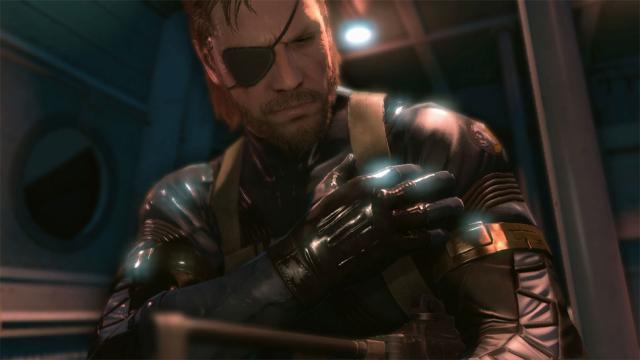Solid Snake is one of gaming’s iconic characters. And in Japan, his voice is as iconic as his look — if not more so.
While the West has David Hayter, and now Kiefer Sutherland as the voice behind the character, Japan has Akio Otsuka, a veteran voice actor whose name has become almost as synonymous with the Metal Gear Solid series as Hideo Kojima. [Update for clarity: Hayter voiced the protagonist in Metal Gear Solid 1, 2, 3, and 4. Sutherland is voicing the protagonist in 5. ]
Much of the character of Solid Snake and afterwards Naked Snake/Big Boss was modelled after Otsuka, from the way he would move to his smoking habit.
In his recent book, Seiyuu Tamashii (声優魂 Voice Actor Soul) Otsuka describes his experience with the Metal Gear series and voicing the lead characters.
At this point [in my life], the characters I played, Solid Snake or Naked Snake, are my alter egos. I’ve spent a long time with them, and my own feedback has been incorporated into the games. They are characters I can act with the mindset “If it was me, I would do this.”
Naked Snake in particular is so much as though you plopped me down as is, you could say “that’s me.” Director Kojima said to me, “Naked is a very human character”, so I used the most human, most base parts of myself for my acting.
Solid Snake is a little different. He carries the issue of being a clone, and carries out his battle between dominant and recessive genes in his conflict with his rival, Liquid [Snake]. He has his darkness, but the excess parts that make him human are thinner than Naked. When playing such a protagonist, the process of “chipping away” is vital. Like carving a statue out of a log, you remove the unnecessary parts from your acting and leave only the core parts of the character.
Compared with anime and movies, games spend much more time with the viewer/player. Not only that, but you control the character yourself and progress the story, so it makes for a very immersive medium. If your acting is too quirky, it becomes overbearing for the player. That’s why you take a step back and focus on relaying the meaning of your dialogue and the story progression to the player in the best way possible. Adjusting like that is part of a voice actor’s job.
Most of Otsuka’s work until that time had been narration work or voice acting parts in anime and dubs, where he could see what was going on or at least have a single unbroken story to model his acting around. Entering the field of video game voice acting, however, was an entirely different ballgame, and in fact, it wasn’t until Metal Gear Solid was released and he played the game for himself that he finally understood what it was he had actually been doing.
My work on Metal Gear Solid started from reading the scenario that was completed at the time. But, what I didn’t realise back then was just how much content was in a game’s scenario. I stared at the pile of paper 20 centimeters high and could only scratch my head thinking, “what kind of story is this?”
I started reading from the beginning, but it’s not like a movie or an anime where the story progresses in a single line, but instead contains broken interactions for each event, making the flow indecipherable. Not only had I never really played video games before, but Metal Gear Solid itself was an entirely new style of game, making the completed form impossible to imagine.
All I could do was make sure what I said came out honestly and act without any unnecessary quirks. Figure out how to relay the meaning of what was written in the sharpest way possible and keep the core of Solid Snake while removing everything else… I focused on that and inch by inch, bit by bit, worked my way through the ocean of text. But even after I have finished recording, I had no idea what was going on. Because I had no visuals to look at, and all I could do was record fragmented scenes.
It was only after I played the game for myself that I understood the whole picture. I’ll never forget that feeling of accomplishment and fulfillment. Because I remembered the dialogue from the various scenes… or rather, I remember saying the dialogue from various scenes, so it felt like I had actually gone to Alaska for a shooting of Metal Gear Solid.
Even if they weren’t actors, everyone who became Snake as players, and after fighting numerous enemies, rode off on that snowmobile, probably came to love Metal Gear Solid from that experience. I think it’s wonderful that such a new entertainment piece that allows you to experience it as though you were in a movie came from Japan, and I am proud to have been part of it.
The series has become a forefront of the Japanese game business, so I’m sure Director Kojima feels a lot of pressure, but I’d like to continue to walk together with Snake until the day he says to me, “Thank you for your work for so long.”
While Hideo Kojima’s status at Konami currently remains shrouded in mystery, Konami has officially stated that it will continue making Metal Gear games. Whether Otsuka will remain the main voice for the series however remains to be seen. Regardless, Otsuka helped create an unforgettable character through his voice — even if he didn’t know what he was doing at the time, in more ways than one.

Comments
2 responses to “The Man Who Brought Solid Snake To Life”
Very interesting stuff. Snake for me will always be David Hayter.
Aww, i hoped this would of been about Hayter